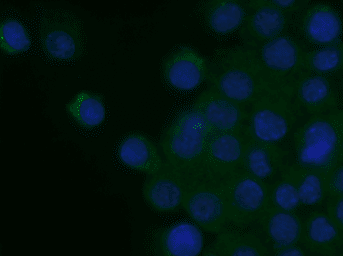TLR9, Mouse, mAb 5G5
€133.00 – €414.00
The monoclonal antibody 5G5 reacts with the Toll-like receptor 9 (TLR9, CD289). TLRs are highly conserved throughout evolution and have been implicated in the innate defence to many pathogens. In Drosophila, toll is required for the anti-fungal response, while the related 18-wheeler is involved in antibacterial defences. In mammals, TLRs identified as type I transmembrane signalling receptors with pattern recognition capabilities, have been implicated in the innate host defence to pathogens. As investigated so far all functional characterized TLR signal via the TLR/IL-1 receptor (IL-1R) pathway where recruitment of MyD88 seems to be essential. In contrast to cell-wall components, bacterial DNA is probably invisible for immune cells until DNA is liberated during processes taking place in the endosomal/lysosomal compartment where intracellular TLR9 recruits MyD88 to initiate signal transduction. Unmethylated CpG-dinucleotide-containing sequences are found much more frequently in bacterial genomes than in vertebrates genomes, whereas the frequency of CpG dinucleotides are suppressed and usually methylated. The regions adjacent to the CpG dinucleotides also affect the immunostimulatory activity. The optimal sequence differs significantly between mammalian species. Methylated CpG dinucleotides lack immunostimulatory activities. Cellular activation in response to bacterial DNA and synthetic dinucleotides containing unmethylated CpG-dinucleotides is mediated by TLR9. The monoclonal antibody 5G5 reacts with RAW macrophages and TLR9 transfected HEK293 cells, and it is cross reactive with canine TLR9.
IF: cells were fixed with 2% formalin for 15 minutes at RT and permeabilized with a mAb (4µg/400µl) containing buffer (PBS, 0.2% BSA, 0.2% saponin)- for 1 hour. (Ref.1)
FC: RAW264.7 cells were fixed for 15 minutes with 4% formalin and permeabilized (PBS, 0.5%BSA, 0,5% saponin) at RT. (Ref.1)
P: paraffin embedded tissues 5µm sections were made. After antigen retrieval (0.01mol/l, pH6 sodium citrate) and quenching of endogenous peroxidase, sections were blocked with 0.5% ovalbumin and 0.1% gelatin for 20 minutes at RT. Sections were incubated with 5G5 for 1 hour at 37 °C. (Ref.3)
W: reduced lysates were resolved by 10% SDS-PAGE and blotted on nitrocellulose. After blocking with 5% skimmed milk TLR9 was detected with 2 µg/ml 5G5. (Ref.1)

